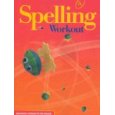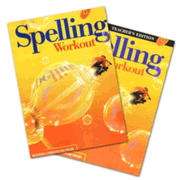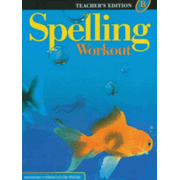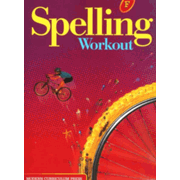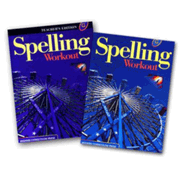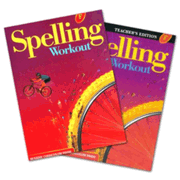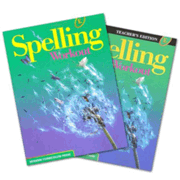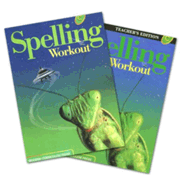The Spelling Workout series, books A through G for grades 1 though 8 respectively, correlates fairly well with Modern Curriculum Press’s Plaid Phonics series. However, Spelling Workout may be used on its own. Although books are printed in only two colors, the layout and illustrations make them fairly attractive.
Spelling is taught from a phonics perspective, gradually shifting emphasis to vocabulary and word origins at the upper levels. Lessons for the first six books follow the same format. They begin with a narrative that uses some of that week’s spelling words. Then students take a pretest, correcting their own work. The next activity generally focuses on a phonic concept common to the list words. Activities on the third page of the lesson vary; they might be analogies, scrambled words, synonyms, antonyms, definitions, crossword puzzles, dictionary work (in student dictionaries at the back of each book), alphabetizing, or similar activities. The final page of each lesson includes proofreading, a writing activity, and a list of a few bonus words to challenge bright students.
Books F and G are slightly different. They forego the opening narrative and jump right into very brief instruction or review on a topic that might deal with phonics, suffixes, word origins, or anything else relating to how words are spelled. This is followed by vocabulary and dictionary activity, then word analysis and word application activities that might deal with synonyms, parts of speech, analogies, or common word elements.
Every lesson includes a puzzle, most of them crossword puzzles. The final page of each lesson, like those in books A through E, has proofreading, a writing activity, and bonus words.
All levels have reviews every five lessons plus review tests in a standardized (fill-in-the-bubble) test format. Books C and up have a few pages at the back for students to write troublesome words for continued review.
Teacher’s Editions have answers overprinted on reduced student pages, surrounded by succinct teaching information. Most useful will be the sample sentences to be used for pre- and post-tests. Some spelling enrichment suggestions at the back of the Teacher’s Editions might be useful, although most are for classroom groups.
One caution: some children, especially those who are dyslexic, are really confused by misspelled words such as those they encounter in proofreading exercises, or they have trouble unscrambling letters to make words. Their brains absorb the images of the incorrect words, so these children build up a confused memory of what the words should look like. In such cases, skip these activities.
Spelling Workout books require no lesson preparation, and students past the first level or two can work through most of their lessons independently.

